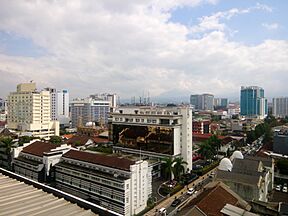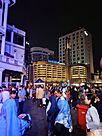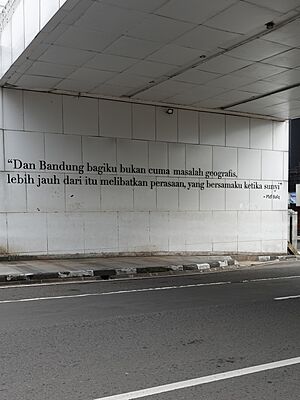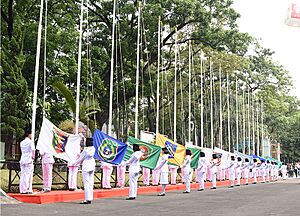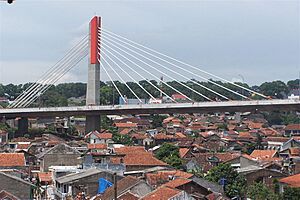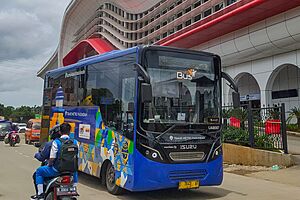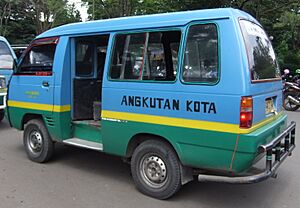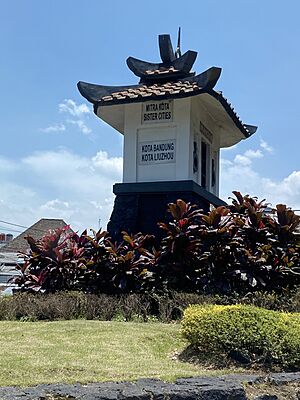Bandung facts for kids
Quick facts for kids
Bandung
|
|||
|---|---|---|---|
|
City
|
|||
| City of Bandung Kota Bandung |
|||
| Name transcription(s) | |||
| • Sundanese | ᮊᮧᮒ ᮘᮔ᮪ᮓᮥᮀ | ||
|
Bandung Skyline
Merdeka Building
Braga Street
Gedung Sate
|
|||
|
|||
| Nicknames: | |||
| Motto(s):
Gemah Ripah Wibawa Mukti
ᮌᮨᮙᮂ ᮛᮤᮕᮂ ᮝᮤᮘᮝ ᮙᮥᮊ᮪ᮒᮤ Prosperous, serene, prestigious, joyous |
|||

Location within West Java
|
|||
| Country | |||
| Region | Java | ||
| Province | |||
| Founded | 25 September 1810 | ||
| Incorporated (as gemeente) |
1 April 1906 | ||
| Administrative division | 30 districts 153 urban villages |
||
| Government | |||
| • Body | Bandung City Government | ||
| Area | |||
| • Total | 167.31 km2 (64.60 sq mi) | ||
| • Urban | 487 km2 (188 sq mi) | ||
| • Metro | 1,876.8 km2 (724.6 sq mi) | ||
| Elevation | 708 m (2,323 ft) | ||
| Highest elevation | 892 m (2,927 ft) | ||
| Lowest elevation | 666 m (2,185 ft) | ||
| Population
(mid 2023 Estimate)
|
|||
| • Total | 2,506,603 (4th) | ||
| • Density | 14,982/km2 (38,800/sq mi) | ||
| • Urban | 7,203,000 (2nd) | ||
| • Urban density | 14,712.5/km2 (38,105/sq mi) | ||
| • Metro | 9,054,175 (3rd) | ||
| • Metro density | 4,453/km2 (11,530/sq mi) | ||
| Demonyms | Bandungite | ||
| Demographics | |||
| • Ethnic groups (2000 estimates) |
List
|
||
| • Religion |
List
|
||
| Time zone | UTC+07:00 (Western Indonesia Time/W.I.B) | ||
| Postcodes |
401xx, 402xx, 406xx
|
||
| Area code | (+62) 22 | ||
| Vehicle registration | D | ||
| Nominal GDP | 2023 | ||
| - Total | |||
| - Per capita | |||
| - Growth | |||
| HDI (2023) | |||
| Largest district by area | Gedebage – 9.58 square kilometres (3.70 sq mi) | ||
| Largest district by population | Babakan Ciparay (142,500 – 2022 est) | ||
| Website | bandung.go.id | ||
Bandung is the capital city of the West Java province in Indonesia. It's located on the island of Java. The larger Bandung area is the second biggest and most populated metropolitan area in Indonesia, with over 11 million people.
Bandung sits about 768 meters (2,520 feet) above sea level. This means it has cooler temperatures all year round compared to most other Indonesian cities. The city is in a valley surrounded by volcanic mountains. These mountains naturally protect the city. This was a main reason why the Dutch East Indies government once planned to move their capital here from Batavia (now Jakarta).
In the 18th century, the Dutch started tea plantations around the mountains. They built a road to connect these farms to their capital, Batavia. In the early 1900s, Bandung became a municipality. It grew into a popular resort city for plantation owners. Fancy hotels, restaurants, and European shops opened. This led to Bandung being called Parijs van Java, which means "The Paris of Java".
After Indonesia became independent in 1945, Bandung continued to grow. It changed from a quiet town into a busy metropolitan area. New tall buildings, bridges, and parks were built. The city has faced challenges like traffic and floods. However, it still attracts many tourists and people moving from other parts of Indonesia. In 2017, Bandung won an award for having the cleanest air among major cities in Southeast Asia. It's also known as a Smart City, using technology to improve services and keep residents informed. Bandung is part of the UNESCO Creative Cities Network since 2015. It is also a major technology center in Indonesia.
The first Asian-African Conference was held in Bandung in 1955. President Sukarno hosted this important event. The city's main airport, Husein Sastranegara International Airport, was updated in 2016. A new, larger airport, Kertajati International Airport, opened in 2018. This was just in time for the 2018 Asian Games.
Contents
Bandung's Past: A Look at its History
The city's official name during the Dutch colonial period was Bandoeng. The earliest records of the area are from 1488. However, old findings show that early humans lived here long before. In the 17th and 18th centuries, the Dutch East Indies Company (VOC) started farms in the Bandung area.
The Great Post Road and City Growth
In 1786, a supply road was built connecting Batavia (Jakarta) to other cities, including Bandung. In 1809, Napoleon ordered improvements to Java's defenses. Governor Herman Willem Daendels then ordered a long road built across Java. This road, called De Groote Postweg (the 'Great Post Road'), passed through Bandung. Today, part of it is Jalan Asia-Afrika.
In 1810, the local leader, R. A. Wiranatakusumah II, moved his office to the current city square. He built his palace, the grand mosque, and a public meeting place there. In 1856, Bandung became the capital of the Preanger Regencies.
Becoming a City and Colonial Plans
The first major railroad between Batavia and Bandung was finished in 1880. This helped Bandung's light industries grow. Many Chinese people came to the city to help with businesses. The area near the train station is still known as the old Chinatown. In 1906, Bandung became a municipality.
In the early 1920s, the Dutch government planned to move their capital from Batavia to Bandung. They started building military barracks and government buildings, like the famous Gedung Sate. But these plans stopped because of World War II.
Bandung's Resort Era
The fertile mountains around Bandung were perfect for tea farms. In the 19th century, cinchona plants were also introduced. Because of its cooler climate and many plantations, Bandung became a special resort area for Europeans. Rich plantation owners visited the city on weekends.
Jalan Braga became a lively street with cafes, restaurants, and shops. Two famous Art Deco hotels, Savoy Homann and Preanger, were built nearby.
Independence and the Asian-African Conference
After Indonesia gained independence in 1945, Bandung became the capital of West Java province. During the Indonesian National Revolution, there were big battles in Bandung. In 1946, Indonesian forces set fire to much of southern Bandung as they left the city. This event is known as the Bandung Sea of Fire.
In 1955, Bandung hosted the first Asian-African Conference. President Sukarno welcomed leaders from 29 independent countries in Asia and Africa. The meeting took place at the Gedung Merdeka. The conference created a declaration for world peace and against colonialism. This event inspired many countries to seek independence. It was also the first international meeting of people of color in history.
Modern Development and Challenges
In 1987, the city expanded with the 'Greater Bandung' plan. This aimed to spread out the population. Old buildings were sometimes torn down to make way for new shops, malls, and banks.
In 2005, another Asian-African Conference was partly held in Bandung. World leaders, including Indonesian President Susilo B. Yudhoyono, attended.
Bandung's Natural Surroundings
Bandung is about 180 kilometers (112 miles) southeast of Jakarta. It sits 768 meters (2,520 feet) above sea level. The city is surrounded by volcanic mountains that can reach up to 2,400 meters (7,874 feet) high.
The flat central part of Bandung is in the middle of a large basin. This basin includes Bandung and nearby cities and regencies. The main river in the basin is the Citarum. The Cikapundung River, a branch of Citarum, flows through Bandung. The Bandung Basin is a vital source of water for drinking, farming, and fishing.
Volcanoes and Fertile Land
The northern part of Bandung is hillier. You can see the unique, upside-down boat shape of the Tangkuban Perahu volcano from the city. Volcanic activity over time has made the soil in the north very fertile. This soil is great for growing rice, fruits, tea, tobacco, and coffee. In the south and east, you'll find soil deposited by the Cikapundung river.
Geologists believe the Bandung Basin is located on an ancient volcano called Mount Sunda. Two huge eruptions happened long ago. The second eruption, around 55,000 BCE, blocked the Citarum river. This turned the basin into a large lake known as "the Great Prehistoric Lake of Bandung". The lake eventually drained, but scientists still debate how.
Bandung's Buildings: A Mix of Old and New

Bandung has many beautiful examples of Dutch colonial buildings. Many are in the tropical Art Deco style, also called New Indies Style. Architect Henri Maclaine Pont was one of the first to combine this style with local Indonesian traditions. In 1920, he designed buildings for the first technical university in the Dutch East Indies, now the Bandung Institute of Technology. You can see a traditional Sundanese roof style on the campus's main hall.
In the same year, another Dutch architect, J Gerber, designed the "Government Companies" building. This building is known as Gedung Sate. It gets its name from the small satay-shaped structure on its roof. Today, it's the main office for the West Java provincial government. The building blends Western and Eastern styles, with Italian Renaissance arches and Javanese pendopo (public meeting place) structures.
Other Dutch architects also added local elements to their designs. In the 1930s, Bandung became a place for architects to try new designs. Albert Aalbers added the streamline moderne style to Art Deco. Charles Prosper Wolff Schoemaker included many native elements in his works. These include Villa Isola (1932) and Gedung Merdeka (1921).
While Bandung is known for its old Dutch buildings, it's also seeing a boom in new, tall buildings. There are over 100 high-rise buildings, with many more being built.
Environmental Challenges
The northern part of Bandung is important for the city's water supply. However, many homes have been built there. Efforts are being made to protect this area, but development continues. Flooding in southern Bandung is also a serious problem.
Bandung has faced challenges with waste management. Despite this, the city has won awards for being one of the cleanest cities in Indonesia. It also received an award from ASEAN for having the cleanest air among major cities in the region.
Bandung's Climate
Bandung has a tropical monsoon climate. This means it has wet and dry seasons. The wettest month is March, and the driest is August. The average temperature throughout the year is cooler than most Indonesian cities. This is because Bandung is located at a higher altitude. Temperatures don't change much throughout the year because the city is near the equator.
| Climate data for Bandung (Husein Sastranegara International Airport) (elevation 740 m or 2,430 ft, 2013–2023, extremes 1957–1994) | |||||||||||||
|---|---|---|---|---|---|---|---|---|---|---|---|---|---|
| Month | Jan | Feb | Mar | Apr | May | Jun | Jul | Aug | Sep | Oct | Nov | Dec | Year |
| Record high °C (°F) | 32.2 (90.0) |
31.1 (88.0) |
32.2 (90.0) |
30.6 (87.1) |
31.1 (88.0) |
30.6 (87.1) |
30.6 (87.1) |
31.1 (88.0) |
32.8 (91.0) |
34.4 (93.9) |
33.9 (93.0) |
31.1 (88.0) |
34.4 (93.9) |
| Mean daily maximum °C (°F) | 28.0 (82.4) |
27.7 (81.9) |
28.7 (83.7) |
28.9 (84.0) |
28.9 (84.0) |
28.7 (83.7) |
28.6 (83.5) |
29.3 (84.7) |
30.0 (86.0) |
30.0 (86.0) |
29.1 (84.4) |
28.5 (83.3) |
28.9 (84.0) |
| Daily mean °C (°F) | 24.2 (75.6) |
24.0 (75.2) |
24.5 (76.1) |
24.8 (76.6) |
24.6 (76.3) |
24.2 (75.6) |
23.8 (74.8) |
24.0 (75.2) |
24.6 (76.3) |
24.9 (76.8) |
24.7 (76.5) |
24.4 (75.9) |
24.4 (75.9) |
| Mean daily minimum °C (°F) | 20.4 (68.7) |
20.3 (68.5) |
20.4 (68.7) |
20.7 (69.3) |
20.3 (68.5) |
19.7 (67.5) |
19.0 (66.2) |
18.6 (65.5) |
19.2 (66.6) |
19.9 (67.8) |
20.3 (68.5) |
20.3 (68.5) |
19.9 (67.9) |
| Record low °C (°F) | 15.0 (59.0) |
15.6 (60.1) |
15.0 (59.0) |
13.9 (57.0) |
13.9 (57.0) |
11.7 (53.1) |
11.1 (52.0) |
11.7 (53.1) |
11.7 (53.1) |
13.9 (57.0) |
12.8 (55.0) |
15.0 (59.0) |
11.1 (52.0) |
| Average precipitation mm (inches) | 174.8 (6.88) |
199.9 (7.87) |
343.2 (13.51) |
275.5 (10.85) |
212.5 (8.37) |
109.9 (4.33) |
77.0 (3.03) |
59.8 (2.35) |
85.3 (3.36) |
174.9 (6.89) |
329.5 (12.97) |
273.8 (10.78) |
2,316.1 (91.19) |
| Average precipitation days | 14.4 | 15.3 | 19.3 | 18.3 | 13.9 | 9.2 | 7.0 | 6.0 | 7.0 | 13.0 | 18.5 | 18.1 | 160 |
| Average relative humidity (%) | 83 | 82 | 82 | 83 | 82 | 78 | 76 | 73 | 74 | 76 | 80 | 81 | 79.2 |
| Source 1: Meteomanz | |||||||||||||
| Source 2: Sistema de Clasificación Bioclimática Mundial (extremes and humidity) | |||||||||||||
| Climate data for Bandung, Indonesia | |||||||||||||
|---|---|---|---|---|---|---|---|---|---|---|---|---|---|
| Month | Jan | Feb | Mar | Apr | May | Jun | Jul | Aug | Sep | Oct | Nov | Dec | Year |
| Mean monthly sunshine hours | 155 | 168 | 186 | 210 | 217 | 240 | 248 | 248 | 210 | 217 | 180 | 186 | 2,465 |
| Mean daily sunshine hours | 5.0 | 6.0 | 6.0 | 7.0 | 7.0 | 8.0 | 8.0 | 8.0 | 7.0 | 7.0 | 6.0 | 6.0 | 6.8 |
| Mean daily daylight hours | 12.5 | 12.3 | 12.1 | 12.0 | 11.8 | 11.7 | 11.8 | 11.9 | 12.1 | 12.3 | 12.4 | 12.5 | 12.1 |
| Percent possible sunshine | 40 | 49 | 50 | 58 | 59 | 68 | 68 | 67 | 58 | 57 | 48 | 48 | 56 |
| Average ultraviolet index | 12 | 12 | 12 | 12 | 11 | 10 | 11 | 12 | 12 | 12 | 12 | 12 | 12 |
| Source: Weather Atlas | |||||||||||||
Bandung is also known for its tornadoes. A tornado in 1933 destroyed homes. Another tornado in 2014 in Gedebage damaged many houses and a factory.
Bandung's Economy and Fun Things to Do
Bandung's economy relies on tourism, business, and creative industries. It also has many high-tech and manufacturing companies. Education, retail, finance, and food production are important too.
The Dago area, once quiet, is now a busy business and entertainment spot. It has many cool cafes and restaurants. Jalan Cihampelas became famous for clothing stores in the 1990s and is still popular today.
Shopping and Creative Culture
Some of the biggest shopping malls in Bandung include Trans Studio Mall Bandung, Summarecon Mall Bandung, and Paris Van Java Mall.
Bandung has a unique "creative culture." Small businesses called "distro" sell products made by local designers. These often include books, indie music, fashion, and accessories. Distros are popular with young people. They are different from factory outlets because they sell unique, locally designed items.
The city government is working to develop special industrial areas. These include centers for knitting, textiles, jeans, shirts, shoes, tofu, and dolls.
Tourism: What to See and Do
Bandung is a popular weekend getaway for people from Jakarta. Visitors come for the cooler climate, delicious food, and affordable fashion. The city also has golf courses and a zoo. Many tourists from Malaysia and Singapore visit Bandung for its cheap textiles and fashion.
In the 1990s, local designers opened denim stores on Jalan Cihampelas. This street became known as "jeans street." Many factory outlets also opened on other streets like Jalan Riau and Jalan Braga. These outlets sell clothes that are "export quality" but at lower prices.
Nature and Museums to Explore
Nearby tourist spots include the Tangkuban Prahu volcano crater to the north. To the south, you can visit the Kawah Putih volcano lake and Patenggang Lake, which is surrounded by tea farms.
For amazing views of the Bandung Basin, visit Caringin Tilu. This forest area is about 1,500 meters (4,921 feet) above sea level and has many pine trees. Another great spot is Taman Hutan Raya Ir. H. Djuanda. The Bukit Moko area is also famous for its views and a giant star statue.
Bandung has several interesting museums. These include the Geological Museum of Bandung, the Indonesia Postal Museum, and the Asian-African Conference Museum. You can also take a ride on the Bandros, a special tourist bus.
People and Culture of Bandung
Religion in Bandung 2021 Islam (92.08%) Protestantism (5.22%) Catholicism (2.17%) Buddhism (0.45%) Hinduism (0.06%) Others (0.02%)
Most people in Bandung are of Sundanese descent. Javanese people are the largest minority group. Other groups include Minang, Chinese, and Batak people. Bandung also has a good number of people from other countries.
| Year | 2005 | 2010 | 2015 | 2020 | 2023 |
|---|---|---|---|---|---|
| Population | 2,288,570 | 2,394,873 | 2,480,615 | 2,444,160 | 2,506,603 |
| Population density (per km2) | 13,679 | 14,314 | 14,826 | 14,609 | 14,982 |
In 2023, Bandung had over 2.5 million people. This makes it the third-most populated city in Indonesia.
Language and Traditions
Bandung is an important cultural center in Indonesia. Most people in West Java are Sundanese. They often speak Sundanese as their first language. It's used for everyday talks in schools, at work, and in markets. Like the rest of the country, standard Indonesian is the main language for government, business, and formal education.
Sports in Bandung
Bandung is home to Persib Bandung, a professional football club. They play in Indonesia's top football league, Liga 1. Bandung also has Prawira Bandung, a professional basketball club.
The roads leading to Lembang and Dago are popular for mountain cycling on weekends. Other popular sports include badminton and golf. There are several golf courses around the city.
Media and Entertainment
Bandung has several local daily newspapers. These include Pikiran Rakyat and Galamedia. There are also local TV stations like TVRI Jawa Barat and Bandung TV. Many radio stations, such as Ardan FM and OZ Radio, broadcast from Bandung.
The city of Bandung was featured in the American reality show The Amazing Race 23.
Getting Around Bandung
You can reach Bandung by highways from Jakarta. The Cipularang Toll Road connects Jakarta to Bandung. It takes about 1.5 hours to drive. There are also other routes you can take. Indonesian National Route 3 connects Bandung to other parts of Java.
The Pasupati Bridge was built to help with traffic in the city. This 2.8-kilometer (1.7-mile) cable-stayed bridge crosses the Cikapundung Valley. It was finished in 2005 with help from Kuwait.
Public Transportation Options
Bandung has two main intercity bus terminals. These will be replaced by a new, larger terminal in Gedebage.
- Taxis and Online Transport: These are easy to find.
- Angkot: These are privately run minibuses. They serve many routes and are cheap, but can be basic.
- Boseh: This is a bike-sharing system provided by the city.
- Buses: Public buses operate throughout Bandung. The city also has its own BRT (Bus Rapid Transit) system called Trans Metro Bandung. A new system called Trans Bagja is planned for 2024. It will use electric buses and have dedicated lanes.
- City Tour Bus: The city government runs a special tourist bus called Bandung Tour on Bus (Bandros).
Trains and Airports
Bandung has two large railway stations: Bandung and Kiaracondong. Train lines connect Bandung to Jakarta and other cities to the east and west. The Whoosh high-speed rail line connects nearby Padalarang and Tegalluar to Jakarta. A special feeder train connects Padalarang HSR station to the main Bandung station.
Bandung's main airport is Husein Sastranegara International Airport (BDO). It has flights to many Indonesian cities and international flights to Kuala Lumpur and Singapore. A new, larger airport, Kertajati International Airport (KJT), opened in 2018. Starting in October 2023, all commercial flights from Bandung will move to Kertajati.
Learning in Bandung: Education Hub

Bandung is a very popular place for education in Indonesia. It has almost 50 higher education institutions. There are hundreds of public and private schools, including junior high schools, high schools, and vocational schools.
Top Universities and Schools
Bandung has many excellent universities. Some of the best include:
- Bandung Institute of Technology (ITB): Indonesia's oldest and most respected technical university, founded in 1920.
- Universitas Padjadjaran (Padjadjaran University): Known for medicine, law, communication, and economics.
- Telkom University (Universitas Telkom)
- Universitas Pendidikan Indonesia (Indonesia University of Education): A leading education university.
There are also international schools in Bandung. These include Bandung Alliance Intercultural School and Bandung Independent School.
Bosscha Observatory
In northern Bandung, you'll find the Bosscha Observatory. It's the only observatory in Indonesia. It was built between 1923 and 1928. In 1959, it became part of the Bandung Institute of Technology.
Bandung's Global Connections
Several countries have consulates in Bandung, like France, the Netherlands, and Poland.
Bandung has sister city relationships with many cities around the world. These partnerships help cities share ideas and culture.
- Almaty, Kazakhstan
- Braunschweig, Germany
- Cotabato City, Philippines
- Fort Worth, Texas, United States
- Hamamatsu, Japan
- Hangzhou, People's Republic of China
- Kuantan, Malaysia
- Kuching, Malaysia
- Las Vegas, United States
- Liuzhou, People's Republic of China
- Melbourne, Australia
- Namur, Belgium
- Pekanbaru, Indonesia
- Petaling Jaya, Malaysia
- Suwon, South Korea
- Tianjin, People's Republic of China
- Udon Thani, Thailand
- Yingkou, People's Republic of China
- Pekan Tutong, Brunei Darussalam
|
See also
 In Spanish: Bandung para niños
In Spanish: Bandung para niños


